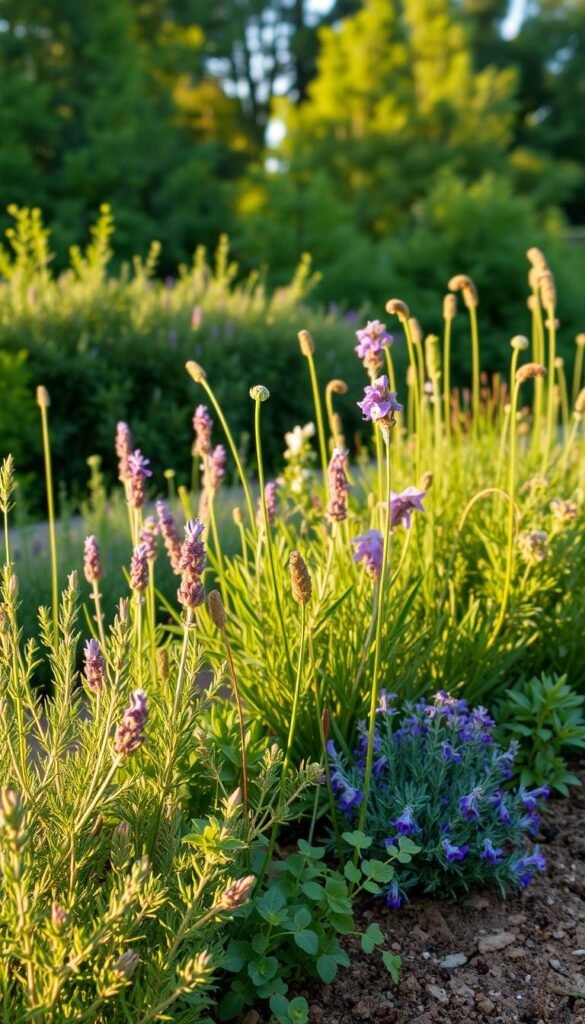Imagine stepping outside and picking fresh flavors for your meals—without replanting each spring. Certain plants thrive for years, making them perfect for busy gardeners. These resilient varieties adapt to different climates, from sunny California to chilly New England.
Unlike annuals, they save you time and money. Once established, they require minimal care while offering both beauty and taste. Think fragrant lavender, earthy thyme, or zesty oregano enhancing your dishes and garden beds alike.
Whether you’re a beginner or a seasoned grower, these selections fit any space. They attract pollinators, resist pests, and add texture to your landscape. Ready to explore the best options? Let’s dive in.
Why Perennial Herbs Are a Gardener’s Best Friend

What if your garden could keep giving without constant replanting? Perennial herbs are the ultimate multitaskers—saving you time, money, and effort while flavoring your dishes and beautifying your space.
Unlike store-bought herbs that add up in cost, these plants pay for themselves. A single rosemary or thyme plant yields fresh herbs for years, cutting grocery trips and packaging waste.
Their deep roots make them drought-resistant, perfect for busy gardeners. Over 70% of mint-family varieties, like oregano and sage, thrive with minimal care. Evergreen options like bay laurel even provide foliage in winter.
From early spring to late fall, your herb garden stays productive. Bees flock to oregano’s blooms, while parsley hosts butterfly larvae. Meanwhile, lavender’s purple spikes add color to borders.
Compare that to high-maintenance crops like tomatoes. No staking, no replanting—just steady harvests year after year. Whether you’re a novice or expert, these low-maintenance stars come back stronger each season.
Top Perennial Herbs for Your Garden
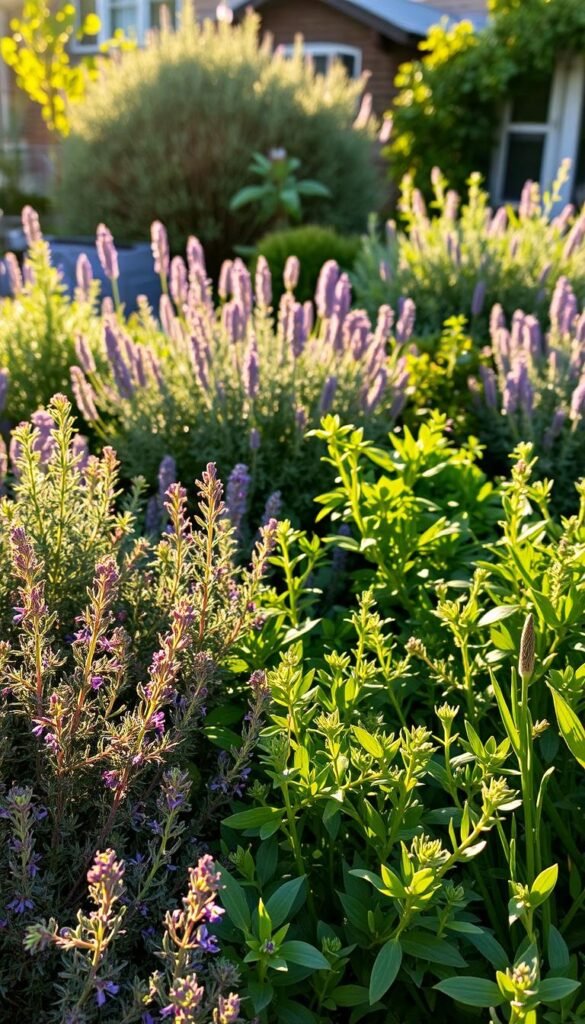
Transform your garden into a low-maintenance flavor hub with these picks. Each offers unique tastes, textures, and benefits—perfect for cooks and gardeners alike.
1. Thyme: The Versatile Ground Cover
This fragrant herb thrives in sunny spots with well-draining soil. Its tiny leaves add depth to soups, roasts, and marinades. Plant between stepping stones for a aromatic path.
2. Lavender: Fragrant and Pollinator-Friendly
Purple spikes attract bees while calming your senses. Dry the blooms for sachets or bake them into cookies. Trim after flowering to encourage bushy growth.
3. Oregano: A Pizza Lover’s Must-Have
Sun-loving oregano packs a punch in Mediterranean dishes. Its flavor intensifies when dried. Perfect for warmer climates or container gardens.
4. Sage: Earthy and Drought-Tolerant
Silvery leaves withstand dry spells and pair well with poultry. Use fresh or dried—its robust taste lasts all season.
5. Chives: Oniony Goodness for Every Dish
Snip the hollow stems over potatoes, salads, or eggs. Pink spring blooms are edible, too. Divide clumps every few years for vigor.
6. Lemon Balm: Citrusy and Invigorating
Rub the leaves for a zesty aroma. Brew tea or infuse desserts. Grows vigorously—plant where it can spread.
7. Mint: Refreshing (But Keep It Contained!)
Spearmint or peppermint thrives in pots to prevent takeover. Add to drinks, sauces, or desserts. Prune regularly to manage growth.
8. French Tarragon: A Chef’s Secret Weapon
Anise-like flavor elevates sauces and fish. Prefers drier soil and full sun. Not to be confused with less flavorful Russian varieties.
9. Bay Laurel: The Evergreen Tree Herb
Grows 30′ tall in-ground but stays compact in pots. Dry the leaves for soups and stews. Note: Toxic to pets if ingested.
How to Plant Perennial Herbs for Success
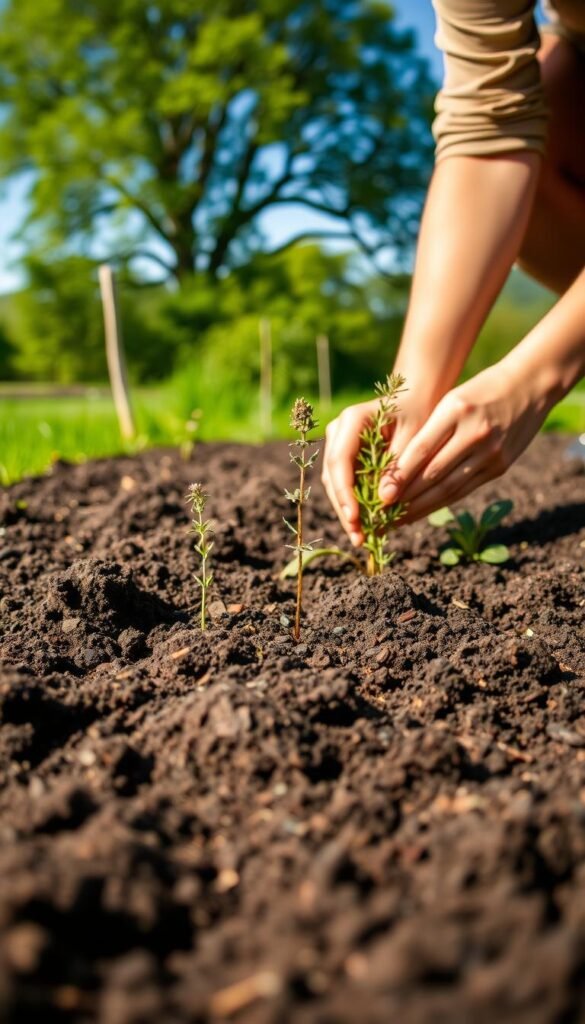
Skip the guesswork—these planting tips ensure perennial success. Start in spring after frost risks pass, giving roots time to establish before summer heat. Well-prepared soil and smart spacing set the stage for years of harvests.
Most herbs crave full sun (6+ hours daily). Lavender and thyme thrive in hot spots, while mint tolerates shade. Use this guide to match plants to your garden’s conditions:
| Herb | Sun Needs | Spacing |
|---|---|---|
| Oregano | Full sun | 12–18″ apart |
| Sage | Full sun | 24″ apart |
| Chives | Partial shade | 8″ apart |
Amend heavy clay soil with 30% coarse sand for drainage. Test pH—most herbs prefer 6.0–7.0. For acidic soil, add lime; for alkaline, mix in sulfur.
Boost root health with mycorrhizal inoculants. These fungi help plants absorb nutrients, reducing fertilizer needs. Plant in batches for staggered harvests—sow chives in early spring, then thyme 2–3 weeks later.
Caring for Your Perennial Herb Garden
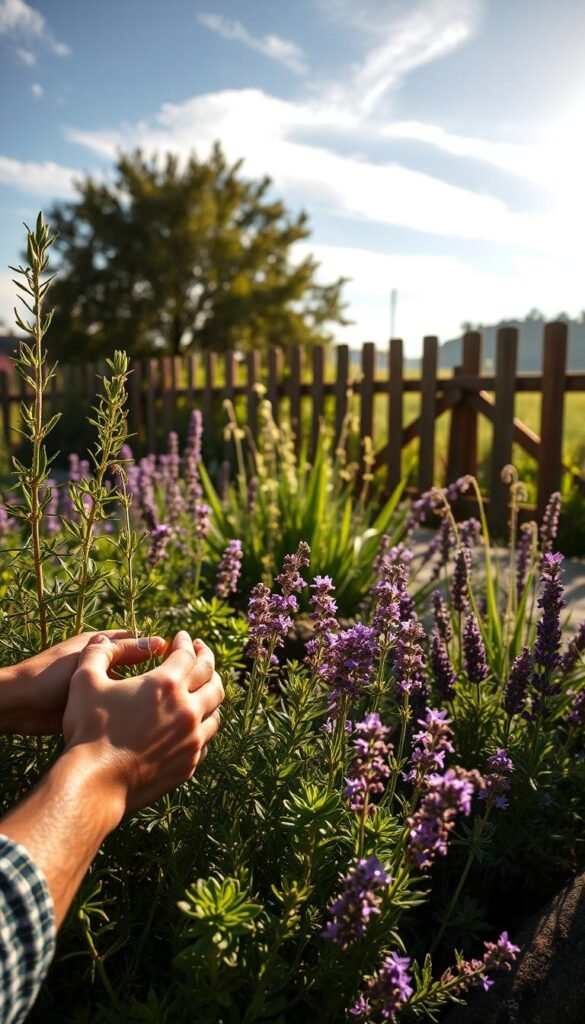
Keep your herb garden thriving with simple, year-round care. Healthy plants reward you with steady growth and flavor—if you follow these key steps.
Mulch Mediterranean herbs like rosemary with gravel. This mimics their native dry soil and prevents root rot. For others, organic mulch (straw or bark) retains moisture in summer and insulates roots in winter.
Stop fertilizing 6 weeks before the first frost. This hardens off tender plants for colder months. In fall, trim dead stems but leave some foliage to protect crowns.
- Prune woody stems: Cut back thyme or sage by one-third in early spring to encourage bushier growth.
- Divide crowded clumps: Every 3–4 years, dig up chives or oregano. Split roots with a knife and replant sections.
- Overwinter wisely: In Zone 5 or below, pot tender herbs (like bay laurel) and move them indoors.
Combat aphids with a soap-water spray (1 tsp dish soap per quart). For whiteflies, hang yellow sticky traps. “Prevention beats cure—inspect leaves weekly,” advises Vermont Extension Horticulturist.
Install drip irrigation to water roots deeply without wetting leaves. This reduces fungal risks and saves 30% more water than sprinklers.
Perennial Herbs vs. Annuals: What’s the Difference?
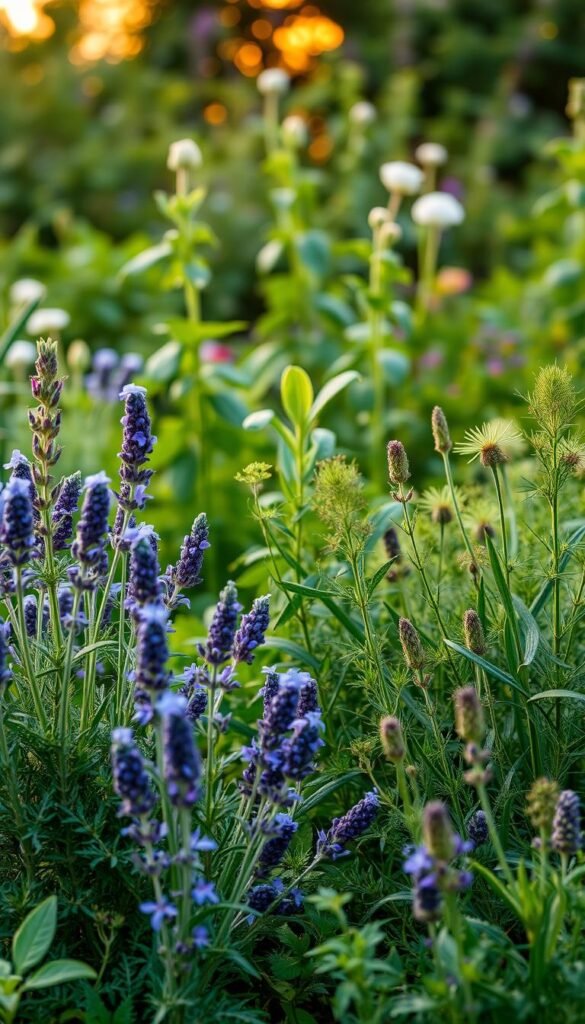
Ever wonder why some herbs vanish after one season while others thrive for years? The answer lies in their lifecycles. Perennial herbs like rosemary and thyme survive winters, regrowing each year. Annual herbs, such as basil, complete their life in one growing season.
Temperature tolerance is key. Basil dies below 50°F, while rosemary withstands 20°F. Your local climate determines whether a plant acts as a perennial or annual. For example, lavender is perennial in Zone 5 but annual in Zone 3.
Strategic interplanting maximizes space and harvests:
- Pair fast-growing dill (self-seeds like a perennial) with slow-establishing sage.
- Use annual cilantro to fill gaps between young thyme plants.
- Rotate mint-family herbs every 3 years to prevent soil-borne diseases.
USDA zones redefine “perennial.” French tarragon thrives in Zone 4+ but needs winter protection in colder areas. Always check zone maps before planting.
“Rotate annual herbs like parsley to new beds each year to avoid pest buildup.”
Save seeds from annuals like chervil for next year’s crop. Meanwhile, divide perennial chives every 3 years to keep them vigorous. With this knowledge, you’ll design a garden that balances both types effortlessly.
Designing Your Herb Garden Layout
Smart layouts turn small spaces into thriving herb havens. Whether you have a sprawling backyard or a balcony, strategic designs ensure every inch works harder. Start by mapping sun exposure—most herbs crave full sun, but some thrive in dappled shade.
Spiral or tiered beds create microclimates. Plant rosemary at the top for drainage, with moisture-loving mint at the base. Raised beds with sandy soil suit Mediterranean plants like lavender and thyme.
For tight spaces, go vertical:
- Hanging planters for trailing oregano or thyme
- Wall-mounted shelves to grow chives and parsley
- Trellises for climbing nasturtiums (edible blooms!)
Pair colors and textures for visual pop. Silver sage contrasts with purple basil, while terracotta pots highlight green foliage. Edge pathways with fragrant lemon thyme—it releases scent when brushed.
| Herb | Companion Plants |
|---|---|
| Basil | Tomatoes, peppers |
| Dill | Cabbage, cucumbers |
For beginners, herbs to grow in containers offer flexibility. Rotate pots seasonally to optimize light. A well-planned herb garden balances beauty, flavor, and function effortlessly.
Harvesting and Using Your Perennial Herbs
Timing is everything when gathering nature’s flavorful gifts. For the richest oils, snip leaves around 10 AM—after dew dries but before midday heat. Morning harvests ensure vibrant taste for dishes or preserving.
Cut stems at a 45° angle just above leaf nodes. This encourages bushy regrowth. For woody herbs like rosemary, avoid cutting into old wood; focus on tender new growth.
Preserve your bounty with these methods:
- Air-drying: Bundle stems and hang upside-down in a dark, ventilated spot. Ideal for thyme or sage.
- Dehydrator: Faster for moist leaves like basil (95°F for 4–6 hours).
- Freezing: Chop herbs into ice cube trays with olive oil—perfect for winter soups.
Elevate everyday meals with herb-infused staples. Mix softened butter with minced chives for savory toast. Or blend coarse salt with crushed lavender leaves—a gourmet finishing touch.
For medicinal uses, steep fresh leaves in vodka for 4 weeks to make tinctures. Strain and store in amber dropper bottles.
“Succession harvesting extends your season—take one-third of growth weekly, allowing recovery.”
In summer, prioritize flowering herbs like oregano for pollinators. By fall, shift to seed collection or root divisions. With these tricks, your herbs fuel kitchens and apothecaries year-round.
Bonus: Self-Seeding Annuals That Act Like Perennials
Nature’s replanting service exists—meet the annuals that behave like perennials. These clever plants drop seeds before fading, ensuring new volunteers sprout each spring. You’ll enjoy their benefits without buying seeds yearly.
Biennial parsley plays the long game. It grows leaves the first year, flowers the next, then scatters seeds for future crops. To manage its lifecycle, plant new batches every summer for uninterrupted harvests.
Save true strains by collecting seeds from your healthiest plants. Let cilantro or dill flower, then snip dried seed heads into paper bags. Store in a cool, dark place—they’ll stay viable for 3+ years.
Control self-sowing with these tricks:
- Mulch lightly to let tiny seeds reach soil but block weeds
- Thin seedlings early to prevent overcrowding
- Rotate planting areas to balance soil nutrients
Dill’s yellow blooms do double duty—they attract swallowtail butterflies while producing next year’s crop. Add the flowers to pickles or salads for a lemony zing.
| Herb | Germination Time | Best for Reseeding |
|---|---|---|
| Parsley | 14–21 days | Partial shade areas |
| Cilantro | 7–10 days | Cool-season gardens |
| Dill | 10–14 days | Pollinator zones |
With these annual herbs, your garden gains the ease of perennials and the freshness of new growth. Just give them space to work their magic—they’ll handle the rest.
Your Year-Round Herb Garden Awaits
Growing perennial herbs unlocks endless flavor and beauty with minimal effort. These resilient plants save you money while boosting your garden’s ecology. Pollinators thrive, and your kitchen gains fresh ingredients.
Start simple with 3-5 easy varieties like thyme, sage, or chives. Match choices to your USDA zone—mint thrives in cooler areas, while rosemary loves warmer spots. Expand gradually as you gain confidence each season.
For beginners, low-maintenance plants offer an easy entry point. Track progress with planting calendars and zone guides. Soon, you’ll enjoy harvests that return every year.
Ready to begin? Grab your gloves—your flavorful, sustainable garden journey starts now.

